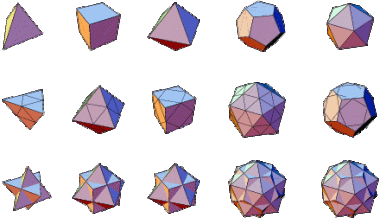Stellations are created when a 2D or 3D figure is extended through different dimensions to form a new figure — stellations typically extend symmetrically until edges or faces of the model meet at a closed boundary.
Stellations are incredibly common in nature, and origami. Scientists and researchers have discovered that repeating patterns, like the ones found in honeycombs or reptile scales, are energetically favorable — meaning that creating these repetitive patterns is easier and faster than creating different ones. Stellations can also be found at the microscopic level, like with viruses, parasitic eggs, or pollen grains!
Additionally, many modular origami models use this principle of stellation to create complex models with identical, symmetrical, repeating units. These models are called polyhedron models, which is a term in geometry that means a 3-dimensional solid with flat faces, straight edges, and sharp corners.

Examples of polyhedra
This type of origami is not only reminiscent of many natural forms, especially those at the microscopic level, but it also represents the intersection between mathematics and art.
Magnus J. Wenninger, a celebrated academic and preeminent researcher on polyhedrons has researched over 100 polyhedron forms and translated them into origami models, most of which are stellated.

Magnus Wenninger (left) surrounded by his stellated polyhedra models. What similarities do you see between the models behind him, and the pollen molecules shown at the top of the page?
Try making your own stellated octahedra here!





